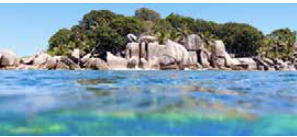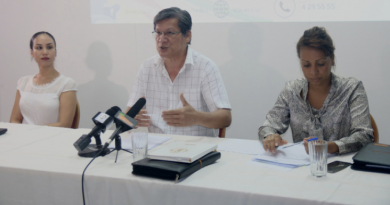The Seychelles Blue Economy: challenges of new Development path
As Seychelles celebrates the 250th birthday of the first human settlement, where have we reached in the delicate mission to balance what we need to do to develop and prosper with how we can safeguard our environmental resources.
It is a fragile task in which our 250-year-old nation sometimes succeeds and sometimes fails.
An important article below on the subject by the India-based Observer Research Foundation (ORF) claims that “Two years since Seychelles adopted the Blue Economy (BE) strategy and linked policies “this balance remains unachieved, yet highly sought after”.
The Seychelles’ geographical advantages have given it economic gains from its main Blue Economy (BE) sectors—fisheries and tourism. However, overexploitation and unsustainable management practices have placed undue pressure on these resources. In 2018, the country conceived a sustainable ocean-based development pathway—the Seychelles’ Blue Economy Strategic Framework and Roadmap. Various socio-economic and environmental challenges threaten to undermine the country’s BE journey, however: a small population size, high dependency on external trade links, and economic susceptibility to natural shocks. Poverty and income inequality persist as well, despite Seychelles being the only country in Africa to have achieved high-income status.
ENTER COVID19
The COVID-19 pandemic has also exposed the dangers of the country’s reliance on a narrow economic base. It has further revealed its dependency on imports for basic commodities, and the underdeveloped capacity for domestic production. To overcome these challenges, Seychelles’ BE must be driven forward by innovation, capacity building, and durable multi-sectoral collaboration.
The country’s economy is dependent on tourism and fisheries. The tourism sector contributes over 80 percent of GDP, with fisheries making up the bulk of the rest. Together, these sectors have helped the Seychelles—the smallest African country—achieve the highest per capita GDP figures in the continent. In 2018, the Seychelles’ GDP at current market prices stood at SCR 22,063.8 million (US$ 1,243.9 million), with a 3.5 percent growth rate estimated in 2019, primarily driven by tourism, fisheries and financial services. In the fourth quarter of 2019, year-on-year real GDP increased by 5.5 percent compared to the same quarter in 2018. Tourism and fisheries also make significant contributions to income and employment—over 25 percent of the country’s 95,000 people are employed in tourism-related industries and 17 percent in the fisheries sector. The country’s primary export base also revolves around fisheries, comprising of consumable fish and fish products, which make up 96 percent of total exports.
UNSUSTAINABLEA
The Seychelles’ locational advantages have allowed it to exploit economic gains from tourism and fisheries. However, overreliance and overexploitation, and unsustainable management practices have placed severe pressure on these economic bases. Given its natural dependence on marine assets, the country decided to refocus its national development strategy around a sustainable Blue Economy (BE).
The BE concept originated at the United Nations (UN) Conference on Sustainable Development in 2012 and derived from the Green Economy idea. It refers to the management of oceans and marine life. However, there is no universally accepted definition of the BE. It holds different meanings for different stakeholders, often resulting in conflicting or blurred applications.
The World Bank defines the BE as the “sustainable use of ocean resources for economic growth, improved livelihoods and jobs, and ocean ecosystem health.” The European Commission sees it as “all economic activities related to oceans, seas and coast. It covers a wide range of interlinked established and emerging sectors.” The Commonwealth describes it as “an emerging concept which encourages better stewardship of our ocean or ‘blue’ resources.” The UN defines it as “an ocean economy that aims at the improvement of human well-being and social equity, while significantly reducing environmental risks and ecological scarcities.”
ALONG UN LINES
The Seychelles’ BE concept aligns most closely with that of the UN, being referred to as “those economic activities that directly or indirectly take place in the ocean, use outputs from the ocean, and put goods and services into ocean’s activities and the contribution of those activities to economic growth, social, cultural and environmental wellbeing.” In framing its BE journey within this definition, the country is seeking to integrate the development of its ocean economy and trade activities with social and environmental concerns within the decision-making process.Having designated the largest percentage of terrestrial space for conservation, the archipelago’s BE agenda further encapsulates this framework for sustainable development. Broadly defined asa process enabling “human beings and communities to achieve their aspirations and full potential over a sustained period of time, while maintaining the resilience of economic, social and environmental systems,” the trans disciplinary framework seeks to equilibrate development, social equity and environmental conservation. The BE model has thus been adopted as the country’s path to sustainable development to fit its priorities, while also emphasizing the importance of working with available and previously unused resources. This has led to greater attention to its ‘secondary space’ of resources—the ocean. By focusing on its extensive oceanic territory as a true space for development, the Seychelles is balancing being a Small Island Developing State (SIDS) and a large oceanic nation. Its BE model is geared to go beyond the current ‘make and waste’ industrial system to foster a restorative circular economy that will take care of future generations.
The Seychelles’ Blue Economy Strategic Framework and RoadmapConceived in 2018 as a pathway to sustainable ocean-based development and growth, Seychelles’ BE framework focuses on strategic initiatives that encourage sustainable and inclusive use of its ocean environment, economic diversification, food security and the conservation of the country’s natural capital. Given that the BE mainly comprises tourism and fisheries, the strategy was also seen as a means to anchor its development to the population’s traditions and way of life. For instance, fishery is perceived asa critical contributor to Seychelles’ cultural identity and other aspects of wellbeing in society, as well as contributing to its food security. However, the BE concept was predominantly a result of the country accepting that sustainable management practices and effective institutional frameworks were urgently needed in the face of mounting challenges.
Over the past three decades, illegal, unregulated and unreported fishing led to an over 60-percent decline in the main fish stocks, resulting in loss of livelihood and revenue for the majority of Seychellois fisher folk. Due to unsustainable fleet expansion and subsidised loans, fishing pressure on marine resources became a national concern. Challenges were also encountered in the fishery export sector—thehigh operating and investment costs made it difficult for the country to meet global quality standards, making its products less competitive in international markets. A lack of development in value-added products coupled with a limited number of processing companies on the island also served to hinder the sector’s growth.
TOURISM VULNERABLE
Seychelles’ tourism sector has also been perceived as vulnerable and over-developed at the expense of others. Land-use conflicts between agriculture and tourism, water shortages, and the government’s inability to regulate development were identified as major challenges. Additionally, the 2008 financial crisis, the 2014 Indian Ocean tsunami and the ongoing COVID-19 pandemic effectively demonstrated the sector’s lack of resilience to external shocks. The country’s tourism sector is predominantly made up of European visitors and is thus dependent on that region’s economic stability. The Eurozone debt crisis, Brexit uncertainties and COVID-19 have created further difficulties for the island nation. With its main income streams from tourism primarily in Euros and its external payments in US dollars, the Seychelles’ trading power has also been significantly impacted. However, it is the adverse effects of global warming and climate change that were the key drivers of the country’s BE strategy. The Seychelles is battling a barrage of threats, including rising sea levels, ocean acidification, increased coral bleaching events, rapidly changing weather and rainfall patterns, and marine pollution.
These events have negatively impacted the country’s fisheries and tourism sectors, coastal infrastructure, biodiversity and marine environment, and the population’s livelihood, food security and health. Given such challenges, the Seychelles government launched the BE Strategic Framework and Roadmap in 2018 with assistance from the Commonwealth Secretariat. The main aims of the plan are:
1. To increase economic diversification and resilience to reduce vulnerabilities and reliance on a minimal number of sectors
2. To increase shared prosperity through the creation of high-value employment and more local investment opportunities
3. To improve food security and overall well-being
4. To maintain the integrity of the ecosystem and habitats through climate resilience and sustainable management ‘DEBT FOR DOLPHIN’ Sovereign Blue BondIn 2018, the country also sold the world’s first Sovereign Blue Bond, a US$15-million instrument, the proceeds of which would be used to expand its marine protected areas, support the growth of a sustainable fisheries sector, and offer grants and loans for ocean-related projects.
Nicknamed the ‘debt for dolphins’ deal, Seychelles became the first country in the world to sell debt that was earmarked especially for ocean-related projects. It also rolled out a comprehensive Marine Spatial Plan (MSP) for its oceanic territory, which allows for the management of Seychelles’ Exclusive Economic Zone through an integrated approach that supports the BE agenda, climate change mitigation and adaptation strategies, and marine ecosystem protection.At the policy level, the Seychelles’ Blue Economy plan demonstrates how countries can bring national development thinking in line with the UN’s Sustainable Development Goals to promote the triple bottom line outcomes of equity, efficiency and sustainability. High-value jobs leading to shared prosperity, social equity and natural resource conservation have been highlighted as key priorities within the roadmap. However, these aims could prove conflicting as the country seeks to exploit oceanic resources for economic gain while balancing the requirements of environmental sustainability and local community needs
Source: orfonline.org



